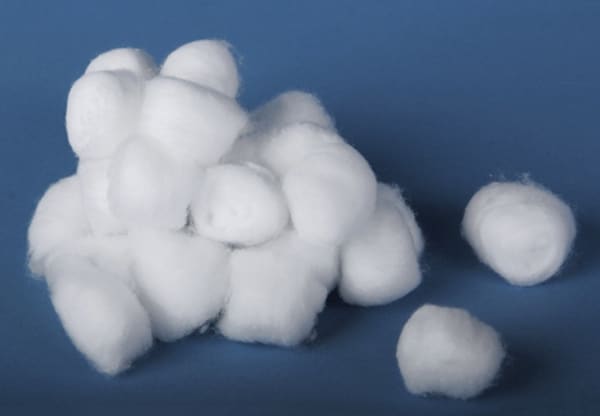Cotton balls are a common household and medical item used in a variety of applications, ranging from cleaning to personal care. When shopping for cotton balls, you may come across two key distinctions: sterile and non-sterile cotton balls. While most people are familiar with the general use of cotton balls, the difference between sterile and non-sterile can be confusing, especially if you’re not working in a medical or clinical setting. So, what exactly do non-sterile cotton balls mean, and when should they be used?
Understanding Non-Sterile Cotton Balls
Non-sterile cotton balls are cotton products that have not undergone a sterilization process to remove all forms of bacteria, viruses, and other microorganisms. In other words, non-sterile cotton balls may contain some level of contaminants, though they are typically not harmful for everyday, non-medical use.
Unlike sterile cotton balls, which are treated to be completely free of microorganisms, non-sterile cotton balls are produced and packaged under conditions that are clean but not subject to the stringent sterilization standards required in healthcare settings. These cotton balls are perfectly safe for many routine tasks but should not be used in situations where sterility is critical, such as wound care, surgeries, or any procedure where open skin is involved.
How Are Non-Sterile Cotton Balls Used?
Non-sterile cotton balls are widely used for a variety of purposes where the risk of infection is minimal. Here are some common scenarios where non-sterile cotton balls are appropriate:
1. Personal Hygiene and Beauty
Non-sterile cotton balls are commonly used in daily personal care routines. They can be used to remove makeup, apply facial toners, or cleanse the skin. In these cases, the cotton balls come into contact with intact skin, so sterility is not typically a concern.
For example, using non-sterile cotton balls to apply cleansing products or lotions is perfectly safe, as there is little to no risk of harmful bacteria causing an infection through intact skin.
2. Household Cleaning
In the home, non-sterile cotton balls are often used for light cleaning tasks, such as applying cleaning solutions to delicate surfaces, wiping electronics, or removing dirt from small objects. They are also useful for polishing silver, cleaning jewelry, or wiping down personal items like glasses or keyboards.
In these tasks, sterility is unnecessary because the items being cleaned are not usually involved in medical procedures or activities where a sterile environment is needed.
3. Arts and Crafts
Non-sterile cotton balls are frequently used in arts and crafts, serving as inexpensive and soft materials for various projects. Whether making decorations, teaching kids how to create cotton ball animals, or using them in school projects, the need for sterility is irrelevant in these contexts. The focus is on convenience, affordability, and availability.
4. Minor Cosmetic Procedures
Non-sterile cotton balls can be used in certain minor cosmetic procedures that don’t involve open wounds. For example, they can be used to clean the skin before or after plucking eyebrows or applying temporary tattoos. Again, in these situations, sterility is not required as the cotton balls do not come into direct contact with broken skin.
5. Medical Situations Without Open Wounds
There are some medical settings where non-sterile cotton balls can be used, such as for external applications like cleaning around an area of intact skin or applying topical medication to areas where there is no risk of infection. For example, non-sterile cotton balls can be used to apply calamine lotion to bug bites or for cleaning around non-broken skin.
When Should You Use Sterile Cotton Balls Instead?
While non-sterile cotton balls are versatile and useful for everyday tasks, there are situations where using sterile cotton balls is necessary. Sterile cotton balls are treated to remove all harmful microorganisms, making them essential for:
- Wound Care: Sterile cotton balls are required when dealing with open wounds, cuts, or burns. Using non-sterile cotton balls in these situations increases the risk of introducing bacteria to the wound, leading to infection.
- Medical Procedures: Sterile cotton balls are used in healthcare settings for procedures such as applying antiseptic solutions, cleaning surgical sites, or dressing wounds. These tasks demand a high level of sterility to prevent complications like infections or sepsis.
- Invasive Procedures: Sterile cotton balls should be used for any procedure that involves breaking the skin, such as giving injections, administering IVs, or performing minor surgeries. This ensures that no bacteria or pathogens enter the body.
How Are Non-Sterile Cotton Balls Packaged?
Non-sterile cotton balls are typically packaged in large quantities in polyethylene bags or containers that are sealed but not hermetically. They are usually labeled as non-sterile so consumers know that they have not undergone sterilization. In contrast, sterile cotton balls are often individually wrapped or come in specially sealed packaging that guarantees their sterility until opened.
Conclusion
Non-sterile cotton balls are widely used in daily activities that don’t require a completely sterile environment. Whether for personal care, cleaning, arts and crafts, or non-invasive cosmetic purposes, non-sterile cotton balls are convenient, cost-effective, and safe for general use. However, for medical and wound care applications where sterility is crucial, it’s essential to opt for sterile cotton balls to prevent the risk of infection. Understanding the difference between sterile and non-sterile cotton balls helps ensure their proper and safe usage in various scenarios.
Post time: Oct-14-2024






